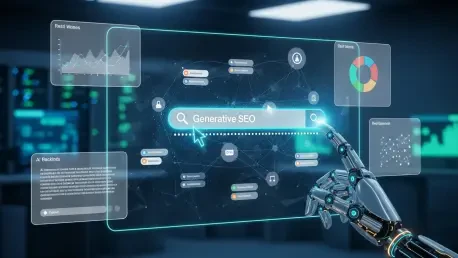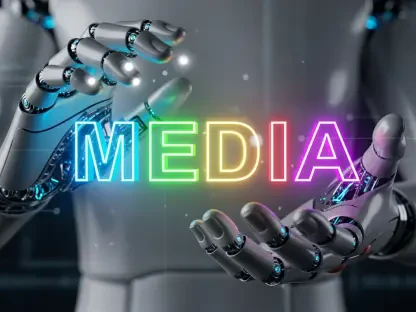In the ever-evolving realm of digital marketing, a staggering statistic emerges: over half of U.S. consumers now rely on AI chatbots for product research, bypassing traditional search engines, which challenges brands to rethink their visibility strategies in a landscape where quick, consolidated answers trump lengthy search results. This seismic shift underscores the urgency for adaptation as AI-driven interactions become the norm, rendering the once-dominant practice of Search Engine Optimization (SEO) less effective and pushing marketers to explore new horizons. This report delves into the critical transition toward Generative Engine Optimization (GEO), examining why adapting to AI systems is no longer optional but essential for sustaining brand relevance in today’s digital ecosystem.
The Evolving Landscape of Digital Marketing
Digital marketing stands at a pivotal crossroads as traditional SEO struggles to maintain its effectiveness amid changing user behaviors. The familiar tactics of keyword stuffing and backlink strategies are diminishing in impact as consumers and B2B buyers increasingly turn to alternative sources for information. This transformation signals a pressing need for brands to reassess how they position themselves online, especially as search engine result pages become less frequented by target audiences.
The rise of AI chatbots as primary tools for information retrieval marks a significant departure from conventional search methods. These intelligent systems deliver direct, synthesized responses, catering to a preference for efficiency over the exhaustive browsing of multiple websites. Key players like Brandi AI LLC are spearheading solutions with innovative platforms designed to address this trend, introducing concepts such as GEO to help brands navigate the new digital terrain.
Adapting to AI-driven interactions is crucial for maintaining brand visibility in this altered environment. As users lean on chatbots for decision-making, the risk of brands fading into obscurity grows if they fail to appear in AI-generated answers. Embracing emerging optimization strategies becomes not just a competitive advantage but a fundamental requirement to stay relevant in a market increasingly defined by artificial intelligence.
The Rise of AI Chatbots and User Behavior Shifts
Key Trends Driving AI Adoption
The growing dependence on AI chatbots for product research and decision-making reflects a profound change in how information is accessed. Users across consumer and business sectors are drawn to the immediacy of chatbot responses, which often distill complex queries into clear, actionable insights. This trend highlights a move away from traditional search engines, where results require additional effort to interpret.
Trust in AI-generated responses further fuels this shift, with many users accepting the first answer provided as authoritative. The preference for quick, consolidated information over sifting through numerous links underscores a behavioral pivot that brands must acknowledge. This reliance on AI systems reshapes expectations, demanding that content be tailored for instant relevance rather than prolonged discovery.
The impact on brand visibility is stark, as failing to appear in chatbot responses can render a brand virtually invisible to its audience. The urgency to adapt to these tools is evident, as marketers must prioritize strategies that align with AI evaluation criteria. Ignoring this evolution risks losing connection with customers who now expect seamless, technology-driven interactions.
Market Insights and Projections
Industry surveys paint a clear picture of AI’s dominance, with studies from Adobe and Forrester revealing that a significant majority of users—over 50% of consumers and nearly 90% of B2B buyers—turn to chatbots for research and purchasing decisions. These figures underscore the scale of adoption and the critical role these tools play in shaping user journeys. Brands must recognize the weight of these statistics as they plan their digital strategies.
Looking ahead, the trajectory of AI adoption shows no signs of slowing, with projections indicating sustained growth in both consumer and B2B sectors from now through 2027. Analysts anticipate that chatbot usage will expand as technology becomes more sophisticated, further embedding AI into everyday decision-making processes. This long-term outlook suggests that brands must prepare for an enduring shift rather than a fleeting trend.
Structural changes in user behavior reinforce the permanence of this transition, as reliance on AI tools becomes ingrained in how information is sought and consumed. Unlike temporary fads, this evolution reflects a fundamental realignment of digital habits, compelling brands to integrate AI-focused strategies into their core operations. The data points to a future where adaptability to these systems will define market success.
Challenges in Transitioning from SEO to GEO
Moving away from entrenched SEO practices presents notable hurdles for brands accustomed to traditional optimization frameworks. Many marketers have invested years in mastering search engine algorithms, and the shift to AI-driven systems requires a complete overhaul of established methods. This transition can feel daunting, as it demands new skill sets and a departure from familiar metrics of success.
A significant challenge lies in the lack of awareness among marketers about their brand’s visibility in AI responses, often leaving them at a disadvantage. Without insight into how chatbots prioritize content, companies struggle to gauge their standing in this new arena. This blind spot can result in missed opportunities to connect with audiences who increasingly rely on AI for guidance.
Technical and strategic obstacles also arise when optimizing content for AI systems compared to traditional search engines. Crafting material that aligns with AI signals such as user intent and trustworthiness requires a nuanced approach, often necessitating specialized tools or expertise. To address these issues, brands can explore solutions like integrating GEO into existing workflows and leveraging platforms designed to bridge the gap between old and new optimization paradigms.
Navigating the New Rules of AI-Driven Visibility
Understanding the principles of GEO is vital, as it focuses on optimizing content for AI-specific signals like clarity, user intent, and site authority. Unlike SEO’s emphasis on keywords and rankings, GEO prioritizes how well content resonates with the logic of chatbot algorithms. Brands must refine their messaging to ensure it meets these criteria, enhancing the likelihood of being featured in AI responses.
Complementary strategies such as Answer Engine Optimization (AEO) play a critical role in establishing brand authority for specific queries. While GEO aims for citation in chatbot links, AEO focuses on positioning a brand as the definitive source for answers, building trust and credibility. Together, these approaches create a robust framework for visibility in an AI-centric digital space.
Competitive tools and platforms, including Brandi AI and Adobe’s LLM Optimizer, offer valuable support in this adaptation process. These solutions provide actionable insights and frameworks to align content with AI expectations, helping brands stay ahead of the curve. Additionally, compliance with evolving digital standards and a commitment to authenticity in AI-optimized content remain essential to maintain user trust and meet regulatory benchmarks.
The Future of Brand Visibility in an AI-Dominated World
The long-term implications of AI’s dominance in digital interactions point to a landscape where traditional visibility tactics will continue to wane. As chatbots become even more integrated into daily life, brands must anticipate further shifts in how their content is discovered and consumed. Staying proactive in adopting AI-focused strategies will be key to sustaining relevance over time.
Emerging technologies and market disruptors are already shaping the future of GEO and AEO, introducing new ways to optimize for AI systems. Innovations in natural language processing and machine learning are likely to refine how chatbots interpret and prioritize content, creating both challenges and opportunities. Brands that monitor these developments can position themselves as early adopters of cutting-edge solutions.
Consumer preferences for convenience and trust in AI responses will drive ongoing change, pushing brands to align with these expectations. Global trends, competitive dynamics, and continuous innovation will further influence growth areas, encouraging companies to explore diverse markets and technologies. The ability to adapt to these evolving factors will determine which brands thrive in an increasingly AI-driven future.
Embracing GEO for Sustained Relevance
Reflecting on the insights gathered, it becomes clear that brands must pivot from SEO to GEO to secure their place in AI-generated responses. This shift is not merely a reaction to trends but a necessary evolution to meet the demands of a digital world dominated by chatbots. The journey underscores the urgency of embracing new optimization practices to avoid obsolescence.
Acknowledging the value of complementary strategies like AEO alongside GEO offers a balanced perspective on achieving visibility. Brands that have integrated these approaches find a stronger foothold in establishing authority and trust. This dual focus proves essential in addressing the multifaceted nature of AI-driven interactions.
Looking ahead, actionable steps emerge as critical for sustained success, including the adoption of specialized platforms to streamline GEO efforts. Investing in training for marketing teams to understand AI signals and collaborating with technology providers opens new pathways for innovation. These strategies position forward-thinking brands to capitalize on the transformative opportunities that lie within this dynamic digital landscape.









